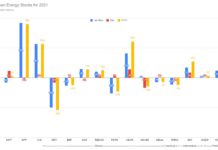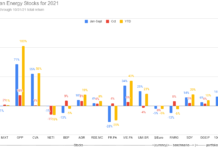My Quick Clean Energy Tracking Portfolio has solidly outperformed its benchmark… was it bad design?
Tom Konrad, Ph.D.
On February 27, I used the top holdings of the (then six) clean energy mutual funds to design a tracking portfolio intended to replicate the performance of those funds at much lower cost. If my methodology was sound, the tracking portfolio should produce returns within the range of returns of the mutual funds on which it was based. If all went well, the returns would be at the upper end of that range because of the way I chose to emphasize stocks which had underperformed over the previous three years.
Tracking Portfolio
| Company | Shares | Price 2/27/09 | Price 5/27/09 | % Change |
| Citrix Systems (CTXS) | 48 | $20.58 | $30.23 | 45.0% |
| Echelon Corporation (ELON) | 165 | $5.99 | $7.12 | 17.3% |
| SunTech Power (STP) | 162 | $6.09 | $15.46 | 150.6% |
| Cemig (CIG) | 94* | $10.47* | $12.67 | 19.4% |
| Vestas Wind Systems (VWSYF.PK) | 22 | $44.85 | $75.10 | 65.8% |
| Total | $4998.65 | $7973.54 | 59.5% |
*Dividend and split adjusted.
And here is the performance of the five remaining clean energy mutual funds:
| Fund | Shares | Price 2/27/09 | Price 5/27/09 | % Change |
| CGAEX (Calvert) | 122.19 | $6.82 | $9.58 | 40.5% |
| ALTEX (First Hand) | 171.47 | $4.86 | $6.47 | 33.1% |
| GAAEX (Guinness Atkinson) | 205.76 | $4.05 | $6.13 | 51.4% |
| NALFX (New Alternatives) | 29.75 | $26.68 | $36.02 | 28.6% |
| WGGFX (Winslow Green Growth) | 111.71 | $7.46 | $10.35 | 38.8% |
| Total | $4999.98 | $6922.87 | 38.5% |
As you can see, the tracking portfolio outperformed all the mutual funds in question, with the portfolio’s performance 9.4% better than the best performance (Guinness Atkinson) of the five funds, and 21% better than the average of the five funds.
Oops
Out performance for a tracking portfolio is not necessarily good news: it may be a sign that the methods used to construct the tracking portfolio are flawed, and the portfolio may be as likely to produce underperformance as out performance. Hence. we should ask:
- Is the out performance statistically significant?
- If yes, is it caused by some systematic factor?
- If a factor or factors can be identified, are they likely to produce out performance in all market conditions, or will they produce underperformance under different market conditions?
Significance
After only 3 months, it’s a little early to draw any conclusions, but the standard deviation of the five mutual fund returns is only 8.6%, so the "Tracking" portfolio’s performance was 2.43 standard deviations above the mean (p-value = 2.43). We can be 99% certain that the returns of the tracking portfolio do not come from the same distribution as the returns of the mutual funds, assuming the fund returns follow a bell curve.
In other words, this is a significant result, and deserves further investigation.
Possible Causes
My first thought was that the out performance was due to my choice to pick the stock in each sector with the worst three year performance record, in order to take advantage of the tendency of long-term losers to outperform in subsequent periods. This is a strategy I’ve discussed before in my article on selling cash covered puts. In order to test this theory, I took a look at what would have happened if I’d chose the best performing stock in each sector, rather than the worst performing stock. The results are shown in my "Winners Portfolio" below:
Winners Portfolio:
| Company | Shares | Price 2/27/09 | Price 5/27/09 | % C hange |
| LSB Industries (LXU) | 114 | $8.66 | $15.09 | 72.0% |
| Echelon Corporation (ELON) | 165 | $5.99 | $7.12 | 17.3% |
| First Solar Inc (FSLR) | 9 | $105.74 | 180.69 | 68.6% |
| South Jersey Industries (SJI) | 28* | $35.74* | $33.35 | -7.9% |
| American Superconductor (AMSC) | 23 | $13.46 | $26.47 | 94.1% |
| Total | $4975.30 | $7387.38 | 48.5% |
*Dividend adjusted.
The Winners Portfolio also outperformed the mutual funds, although not at a statistically significant level. Nevertheless, if the out performance of the tracking portfolio were to be described only by winner/loser effects, we would expect the Winners Portfolio to under-perform the funds. Although it seems like winner/loser effects might be part of the explanation, they are far from complete.
Other Potential Biases
Two other biases to consider are
- The sector weights in my tracking portfolio are 20% in each sector, which does not mirror the funds’ sector weights (and underemphasizes Wind and Solar.)
- I chose the stocks from the top five holdings of each fund, rather than the complete holdings of all the funds.
Upon examination, explanation #1 fails, since the four stocks (Suntech, Vestas, First Solar, and American Superconductor) had better performance than either the tracking or winners portfolios as a whole. If I had increased the allocation to any of these stocks, the new portfolios would have performed even better than these two.
The explanation I’m left with is #2. The top five holdings of the funds are those stocks that, for whatever reason, the funds feel most comfortable holding in large quantities. If we assume that the fund managers are good enough at their jobs that their judgments are useful, then concentrating on the top five holdings might mean that we are simply benefiting more from the fund mangers’ skill (by holding a relatively undiversified portfolio) than investors in the funds are themselves. However, there is some question as to whether most mutual fund manages add value. On the other hand, research shows that mutual fund disclosure does hold useful information on outperforming the market.
On the other hand, mutual funds might be holding more of certain stocks because of factors other than expectations of future performance. For instance, they might only want to hold large quantities of companies which are more liquid, are larger, or are currently more profitable or growing faster. To the extent that any of this is true, we should be concerned that while the market has favored these preferred types of companies over the last three months, that could change at any time, and cause under-performance in the future.
Conclusion
My guess is that my focus on only the top five holdings of each fund caused much of the significant tracking error. To avoid this tracking error in the future, I would need to look at the funds’ full portfolios.
I will revisit this tracking portfolio again next quarter to see if it continues to outperform, or if the trend reverses itself, and to see if I can draw any further conclusions.
DISCLOSURE: Tom Konrad and/or his clients own LXU, ELON, and AMSC. The Guinness Atkinson Fund is an advertiser on his website, AltEnergyStocks.com
DISCLAIMER: The information and trades provided here and in the comments are for informational purposes only and are not a solicitation to buy or sell any of these securities. Investing involves substantial risk and you should evaluate your own risk levels before you make any investment. Past results are not an indication of future performance. Please take the time to read the full disclaimer here.







